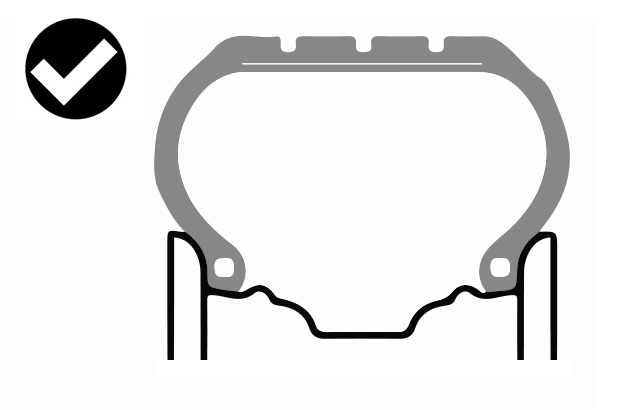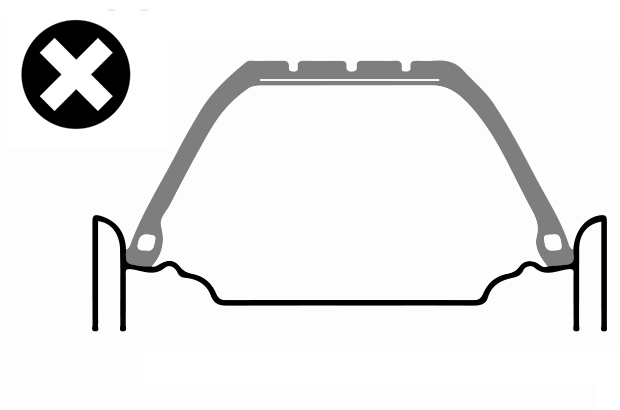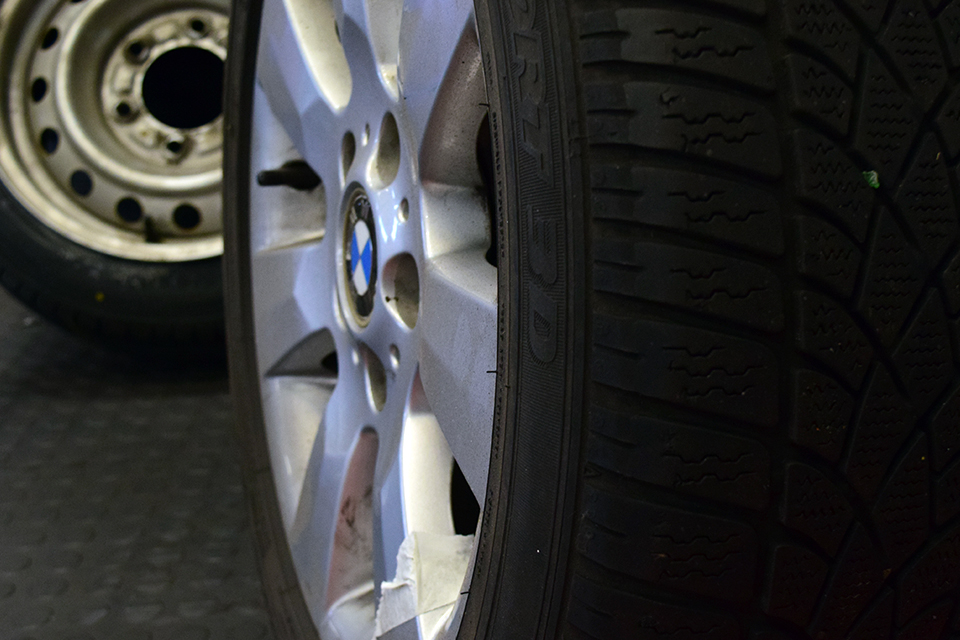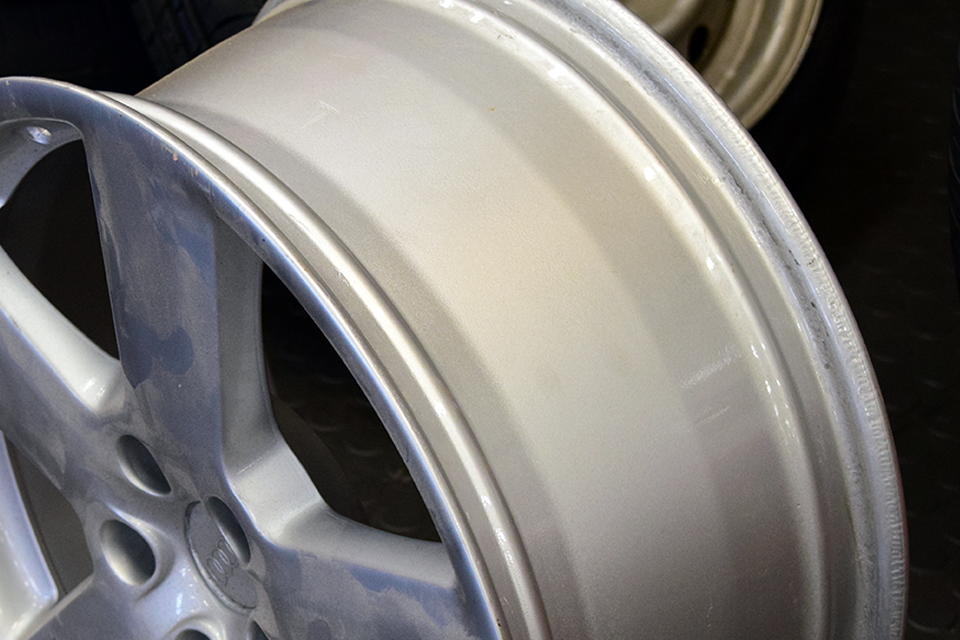We're often asked whether ‘stretched’ or ‘Euro look’ tyres are an MOT failure.
To justify a failure, the tyre or its fitment must breach The Road Vehicles (Construction and Use) Regulations 1986 as amended. While the regulations are specific about tread depth, cuts, speed ratings etc, the fitting of a tyre on an unsuitable size wheel rim is not specifically covered.
The regulations say that “a tyre should not be used on a road if it’s not maintained in such condition as to be fit for the use to which the vehicle is being put”. This means the tyre must be fitted on a suitable wheel with a suitable valve etc.
This part of the regulation therefore gives you reasons for rejection such as:
- damaged or misaligned valve stem
- tyre incorrectly seated on the wheel rim
But how ‘stretched’ would a tyre need to be before it’s in breach of the regulation, and how would you prove it?
The European Tyre and Rim Technical Organisation publish a standards manual with approved rim widths for all sizes of tyre. However, if a tyre is fitted outside of this recommendation, it does not necessarily mean the tyre will be incorrectly seated on the rim.
Whether the tyre is correctly seated will also depend of the tyre make, load carrying capacity, rim design etc. The following diagrams are representative of a correctly and incorrectly seated tyre.


In this example, the wheel rim and tyre are incompatible and there is a clear gap between the tyre bead and the wheel rim because the tyre is over-stretched.
When this happens, the vehicle should be rejected for the tyre being incorrectly seated on the wheel rim. Where this isn't obvious, the nominated tester should pass and advise.
Another thing to note is that the driver of a vehicle with narrow tyres on wide rims may find that their insurance is invalid in the event of a claim.
If you have any examples of extreme stretched tyres, please email the photos to MattersOfTesting@vosa.gsi.gov.uk.
This article was updated on 26 May 2016 to include clearer diagrams of correctly and incorrectly seated tyres.


53 comments
Comment by garth ibbetson posted on
Stop moaning .. its illegal to have stretched tyres ..
Anything that is changed from factory standard must be notified to you insurance company.. if not, the police can check and you will be done.
Comment by Christian posted on
I've been driving on stretched tyres for 4 years now, current car drives comfortably, flat out round bends, anywhere at 285bhp with a 215 on a 10" rim. The reason we do this is so the rim can sit more flush against the bodywork and because we can...why not? I love reading people trying to talk about the dangers of it etc without any solid evidence at all. People live lives so conservatively!
Comment by Bob posted on
Got to love a boy racer and the rubbish they talk
Comment by Phil h posted on
Don't like stretched tyres I have just done my three day mot Course and took this up with the tutor the funny thing was my so is into all this Euro style wheels so whilst going down a lane with his tyres euro style he hit a boulder in the road only at 30mph it totally took out his tyre and turned it egg shaped so this is one good reason why this method of fitting tyres should not be practised he had to get new tyres fitted this time he got the correct sizes .
Comment by Hank posted on
surely the manufactures could easily emboss the minimum and maximum wheel width for the tyre size on the tyre itself. this would make easier to check by testers.
Comment by Mick posted on
I am neither a tyre fitter, nominated tester nor do I have any connection with the motor trade.
Who ever did the drawing of and explanation of a stretch tyre should have their crayon taken
away and be sent back to junior school. As stated by several sensible NTs it's impossible for
the bead to turn through 90deg, even if it were possible the inside diameter of the tyre would
increase by anything between a half to one inch depending on bead construction. So taking
the half inch as an example the id of a 13inch tyre becomes 13 &1/2ins and clearly would
never seat down on a 13ins rim.
Also as one NT mentioned the lateral flexing of the carcass becomes compromised, which
would result in early lack of traction and rapid slip/drift when pushed hard into a bend, if an
idiot with such a wheel/tyre combination losses it on a bend he may at best "ef" up his wheels
or at worst take someone out with him/her.
And finally. As all of the examples that I have seen and followed, all appear to have retained
the standard fit tyres on extra wide wheels whereby the tyre remains within the bodyline but
the wheel itself projects beyond, and are therefor a justifiable mot failure.
Comment by Mark posted on
Stretch tyres are a death trap full stop a tyre was designed so that when going around bends and corners the tyre wall would flex either a little or a lot but with them stretched tyres the side walls are already stretched to the extremes so the only thing that can happen with them is it pulls the tyre bead off it's seat and deflate.
Comment by man posted on
Oh don't cry about it
Comment by Dave W posted on
Surely the majority of those with vehicles fitted with stretched tyres and/or aftermarket HID lamps remove them before presenting? Is this not a matter for the Police to deal with?
Comment by Chris posted on
Maybe tyre manufactures should produce a list of maximum rim size per tyre width. Also i think its not just the boy racers to blame but the incompitent tyre fitters fitting these tyres. Before long theres going to be a serious incident witb this stupidity. Needs sorting before someone is seriously hurt.
Comment by Shane posted on
Where have you been ?
Comment by Malcolm Wilcox posted on
Sounds like some of the comments being made are by people that do not understand the tyre sizes, aspect ratio, section of the MOT Testing guide. If these remarks are by NT's I can only suggest that there AE's give them more time and instruction on section 4 of the MOT inspection manual. I have experienced this practice of narrow tyres being fitted to wide rims quite a lot. It seems to becoming a trend with the younger drivers of today. I don't understand why. 1 they look stupid and totally out of shape. 2 they look totally dangerous to other road users. Malcolm
Comment by Ads80 posted on
Maybe do one of these for the idiots diving round with blinding HID kits in standard halogen headlamps!! So dangerous
Comment by mat posted on
still a grey area over what is. are you saying if the bead has rotated 90 degrees or the face the bead can be seen.
what would clarify it, is stating the tyres width can not be less than 90% the width of the wheel.
so say putting a 215/35/19 on a 9j wheel would be 8.46" width tyre on a 9" wheel. being 94% (6% stretch) in this example, so you could say this is a pass but maybe an advise as it is really the least ideal tyre for the width of the wheel
but on a 10j wheel with that same size. 215/35/19 that would be a more extreme stretch and gives 84.6 (15.6%) so making that illegal
and in actual fact, the first example gives stretch without showing bead and allowing the tyre the seat where the second example, altho the tyre seats, the bead can be seen
now isnt that an easier way to do things
Comment by phil posted on
it sounds like we have to be a technical engineer again, who,s to say what is safe or not ????
Comment by brian stallard posted on
surely we should stick to what is reccommended by manufacturer. as with other aspects for mot. would it affect addhesion or water displacement etc.
Comment by gazzol posted on
Hope this helps some testers out there.
Diagram 2 isn't correct, in cases of extremely stretched tyres the bead doesn't rotate as in diagram 2 what actually happens is that the whole of the bead of the tyre doesn't contact the side of the rim. There is infact a gap betweeen the rim and the tyre and you can see the back side of the rim. The more extreme the stretch the more of the inside of the rim you can see. In the most extreme case I've seen (at a VW show) you could see the base of the rim!
Comment by jason williams posted on
the diagram is ridiculous..a tyre bead would not turn itself on its side like that no matter how wide the wheel,,and neither would it inflate if it did..i have fitted tyres from cars to earthmovers with locking beads..the only danger with stretched tyres is the sidewalls are more vunerable to damage,,
Comment by Dougal posted on
Beevus Brown would pass that
Comment by Dan posted on
Blimey - nice to see common sense being employed! Not all 'stretched' tyres are dangerous if done within sensible limits and it's refreshing to see that that's acknowledged here.
Comment by Phil Thirsk posted on
All Tyre Manufacturers design tyres to fit certain rim sizes and all rims are designed also to fit certain tyre sizes and they use the guidelines produced by ETRTO.
This is in order to optimize the design for the four function of a tyre, to provide Friction for braking and acceleration, Steering, support the Load and vehicle Suspension. Coupled with these basic functions is fuel efficiency and long life all of these points defeat the function of a tyre when fitted stretched or Euro style.
In my opinion they do not conform to the vehicles construction & Use, however I am pleased that this instruction and recommendations have been issued to vehicle testers, technical data is available for Tyres and Wheels at (ETRTO http://www.etrto.org).
Training & Development Manager (Tyre Manufacturing)
Comment by ian lennon posted on
photos of an actual wheel rim and a stretched tyre would have been better .
Comment by Stuart Lambert posted on
Michelin produce a Technical Data guide that gives Minimum/Optimum/Maximum rim widths for each of their tyres and it would be nice to be able to reference this info and include it in an advisory.
So for a 205/55R16 Michelin the acceptable rim widths are: Min 5.5J - Opt 6.5J - Max 7.5
I find it scary that cars presented with this 'styling' usually have budget tyres fitted. So not only are the tyres sub standard but they are also operating outside of their designed parameters.
Comment by Lee posted on
Defiantly illegal I'm afraid, and the police are having a massive crackdown on stretched tyres to the point that the police will now go to the tyre fitters them selves who can now get in more trouble for sending out a car in a dangerous condition, than the driver can get for using the car!
Comment by Jim posted on
So, to clarify, you can only fail if the bead is 90' rotated (a bead sealing surface now facing upwards)......which would never happen anyway as its virtually impossible to achieve..... the inflation pressure would want to pull the beads back into their natural position.
Conclusion - you will never see that diagram so stretched tyres are OK.
Comment by Paul posted on
Very interesting info. Thankyou.
I'm used to seeing the opposite issue when some motorcycles are presented with a distorted profile rear tyre, being clearly far too wide for the rim it's fitted to.
Paul.
Comment by max posted on
at last something is being done
Comment by Tim bluck posted on
This definitely clears up some confusion on what seems to becoming more noticed on modified vehicles.
Comment by Stuart Duff posted on
Never seen a vehicle presented but I have seen some ridiculous examples on the road , goodness knows how they must handle. An insurance advisory message would certainly make the presenter pretty hacked off and aware of the implications in an accident or claim.
Comment by shaun posted on
in order for the bead to be in this postion the force would have to come from the top
Comment by shaun posted on
not being funny but the second diagram could never happen.
in order to blow a tyre up the bead has to push against something, in this photo it isnt
Comment by Chris posted on
Shaun under normal circumstances you'd be right, these so called stretched tyres are inflated by igniting a flammable gas inside the tyre , the rapid expansion is how they r seated on the rim.
Comment by C.MCDADE posted on
will 165/45/15 pass if fitted on a 8j rim?
Comment by Stuart Lambert posted on
I would suggest not - according to Michelin (sorry) the only 15" tyre suitable for an 8j rim would be a 225/50R15.
They don't make the size you list but it looks like the max rim width would be round about 6 - 6.5j
Comment by Derek posted on
are you having a laff ? I would not want to be on a road near you and your death trap.
Comment by c.mcdade posted on
its hardly a death trap, there isnt any way the tyre is gonna come off the bead unless my tyre pressure drops below 38psi. ill stick it threw mot an let you all know. my tyre make is nankang
Comment by h.c posted on
not likely , I have 195 50s on an 8 and they'll probably fail.
Comment by Si posted on
They simply go by tyre manufactures width size
So if a tyre is designed for a 8-9j wheel and it's on a 10j then it would fail
But unless it's obvious then it will pass as nobody knows what what each tyre manufacture has for each tyre size without researching it
Comment by Gilbert posted on
Thank you, this makes it a lot clearer. Basically stretched tires are legal unless it's an extreme example
Comment by bazza posted on
looks like you made the wheel rim smaller on second pic, otherwise both pics would have the same amount of seal? please clarifiy. are you suggesting that if the beed can be seen then it must be illegal? even if it has the same amount of seal as an unstreched tire? would have thought, gov.uk could do better than that! lets have a properly tested engineering explanation thank you very much!
Comment by Mat posted on
The bead is rotated 90' on the stretched rim!
Comment by Matters of Testing posted on
Hi Bazza,
The purpose of the two images is to show the same size tyre on different size wheels. The first being a wheel of the correct size for the tyre and the second being a wheel far too wide for the section width of the tyre.
The second image shows that the tyre bead has turned through 90 degrees and the tyre is therefore incorrectly seated on the rim and is an MOT failure. The images are deliberately simplistic and are designed this way to get the intended message across, with the text between the images giving the engineering explanation for why the fitment shown in the second image is unacceptable.
Kind regards,
Sarah
Comment by Hillbily posted on
Very useful info. Explanation and diagrams are easy to interpret.
Comment by jo cole posted on
here is a site where you can get loads of pictures so you can update this so people have a better understanding of what is and isnt acceptable.. as at the moment this is a poor example and still makes it a grey area.
https://tyrestretch.com/
Comment by Jamie posted on
Sarah u must be thick for the bead of the tyre to sit as on second PIC it would clearly blow of the rim some people really aint all that clever plz revise and actually test in life not diagrams !!!!
Comment by badger posted on
exactly!. simple diagram. if you cannot see the difference then maybe it's not the diagram that's simple?
Comment by mat posted on
bazza, that's because they have used the same with and profile tyre on a wider wheel. which is kinda how stretched tyres work
Comment by Elias posted on
Well done DVSA for finally having the guts to clear this up!! Top article.
Comment by N. PARFITT posted on
thanks for good information will pass this onto my testers.
Comment by Ben mayne posted on
Thanks for clearing this up. Hopefully most testers shouldn't come across this too often
Comment by d bradley-scrivener posted on
been fourtunate enough not to have a vehicle presented this way but the information is good to have. thanks
Comment by M. Gibson posted on
Thank you for this information, it is gratefully received for my son whose car needs new tyres
Comment by p clark posted on
stretched tyre info very useful. thank you.